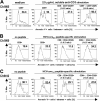Foxp3+CD4+CD25+ T cells control virus-specific memory T cells in chimpanzees that recovered from hepatitis C
- PMID: 16478885
- PMCID: PMC1895795
- DOI: 10.1182/blood-2005-09-3903
Foxp3+CD4+CD25+ T cells control virus-specific memory T cells in chimpanzees that recovered from hepatitis C
Abstract
Hepatitis C virus (HCV) poses a global health problem because it readily establishes persistent infection and a vaccine is not available. CD4(+)CD25(+) T cells have been implicated in HCV persistence because their frequency is increased in the blood of HCV-infected patients and their in vitro depletion results in increased IFN-gamma production by HCV-specific T cells. Studying a well-characterized cohort of 16 chimpanzees, the sole animal model for HCV infection, we here demonstrate that the frequency of Foxp3(+)CD4(+)CD25(+) regulatory T cells (T(Regs)) and the extent of suppression was as high in spontaneously HCV-recovered chimpanzees as in persistently HCV-infected chimpanzees. Foxp3(+)CD4(+)CD25(+) T(Regs) suppressed IFN-gamma production, expansion, and activation-induced cell death of HCV-specific T cells after recovery from HCV infection and in persistent HCV infection. Thus, T(Reg) cells control HCV-specific T cells not only in persistent infection but also after recovery, where they may regulate memory T-cell responses by controlling their activation and preventing apoptosis. However, Foxp3(+)CD4(+)CD25(+) T(Reg) cells of both HCV-recovered and HCV-infected chimpanzees differed from Foxp3(+)CD4(+)CD25(+)T(Reg) cells of HCV-naive chimpanzees in increased IL-2 responsiveness and lower T-cell receptor excision circle content, implying a history of in vivo proliferation. This result suggests that HCV infection alters the population of Foxp3(+)CD4(+)CD25(+) T(Reg) cells.
Figures







Similar articles
-
Identification and in vitro expansion of functional antigen-specific CD25+ FoxP3+ regulatory T cells in hepatitis C virus infection.J Virol. 2008 May;82(10):5043-53. doi: 10.1128/JVI.01548-07. Epub 2008 Mar 12. J Virol. 2008. PMID: 18337568 Free PMC article.
-
Functional suppression by FoxP3+CD4+CD25(high) regulatory T cells during acute hepatitis C virus infection.J Infect Dis. 2008 Jan 1;197(1):46-57. doi: 10.1086/523651. J Infect Dis. 2008. PMID: 18171284
-
Kinetics of CD4+ and CD8+ memory T-cell responses during hepatitis C virus rechallenge of previously recovered chimpanzees.J Virol. 2003 Apr;77(8):4781-93. doi: 10.1128/jvi.77.8.4781-4793.2003. J Virol. 2003. PMID: 12663785 Free PMC article.
-
Defining target antigens for CD25+ FOXP3 + IFN-gamma- regulatory T cells in chronic hepatitis C virus infection.Immunol Cell Biol. 2007 Apr-May;85(3):197-204. doi: 10.1038/sj.icb.7100020. Epub 2007 Jan 2. Immunol Cell Biol. 2007. PMID: 17199111
-
Level, phenotype and activation status of CD4+FoxP3+ regulatory T cells in patients chronically infected with human immunodeficiency virus and/or hepatitis C virus.Clin Exp Immunol. 2009 Jan;155(1):35-43. doi: 10.1111/j.1365-2249.2008.03797.x. Clin Exp Immunol. 2009. PMID: 19076827 Free PMC article.
Cited by
-
Immunohistochemical investigation of Foxp3 expression in the intestine in healthy and diseased dogs.Vet Res. 2012 Mar 22;43(1):23. doi: 10.1186/1297-9716-43-23. Vet Res. 2012. PMID: 22440243 Free PMC article.
-
Natural regulatory T cells and persistent viral infection.J Virol. 2008 Jan;82(1):21-30. doi: 10.1128/JVI.01768-07. Epub 2007 Sep 12. J Virol. 2008. PMID: 17855537 Free PMC article. Review. No abstract available.
-
Altered frequency and phenotype of CD4+ forkhead box protein 3+ T cells and its association with autoantibody production in human immunodeficiency virus-infected paediatric patients.Clin Exp Immunol. 2012 May;168(2):224-33. doi: 10.1111/j.1365-2249.2012.04569.x. Clin Exp Immunol. 2012. PMID: 22471284 Free PMC article.
-
An insight into the diagnosis and pathogenesis of hepatitis C virus infection.World J Gastroenterol. 2013 Nov 28;19(44):7896-909. doi: 10.3748/wjg.v19.i44.7896. World J Gastroenterol. 2013. PMID: 24307784 Free PMC article. Review.
-
Identification of CD4 T-cell epitopes in soluble liver antigen/liver pancreas autoantigen in autoimmune hepatitis.Gastroenterology. 2008 Dec;135(6):2107-18. doi: 10.1053/j.gastro.2008.07.029. Epub 2008 Jul 31. Gastroenterology. 2008. PMID: 18773898 Free PMC article.
References
-
- Sakaguchi S, Sakaguchi N, Asano M, Itoh M, Toda M. Immunologic self-tolerance maintained by activated T cells expressing IL-2 receptor alpha-chains (CD25). Breakdown of a single mechanism of self-tolerance causes various autoimmune diseases. J Immunol. 1995;155: 1151-1164. - PubMed
-
- Belkaid Y, Piccirillo CA, Mendez S, et al. CD4+CD25+ regulatory T cells control Leishmania major persistence and immunity. Nature. 2002;420: 502-507. - PubMed
Publication types
MeSH terms
Substances
Grants and funding
LinkOut - more resources
Full Text Sources
Medical
Molecular Biology Databases
Research Materials

